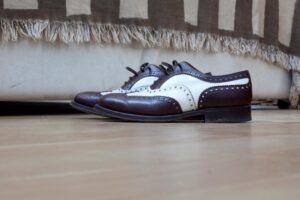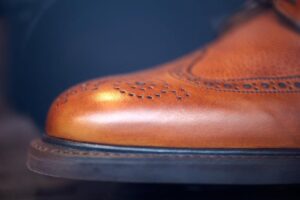When investing in premium quality footwear, a pivotal question arises: is it advantageous to add toe taps to your shoes? As you navigate this crucial shoe care choice, understanding the multitude of benefits that toe taps offer becomes essential. They provide outstanding protection for the soles of your shoes, ultimately saving you a substantial amount on future repairs. Given that your walking pattern exerts natural pressure on the toe area, this part of the shoe is particularly vulnerable to wear and tear. Although toe taps may seem like an additional expense, they deliver long-lasting protection for your footwear investment. It’s important to evaluate factors like your walking style, the frequency of shoe rotation, and the types of surfaces you typically encounter before deciding.
Discover the Fascinating History and Evolution of Toe Taps in Footwear
Historically, before toe taps became a staple among discerning shoe owners, it was observed that only 10% of footwear owners opted for them. Your perception of toe taps has transformed significantly since 2014, a landmark year when numerous shoemakers began integrating pre-installed toe taps into their shoe designs, enhancing both their appeal and practicality. This shift represented a major turning point in the industry, as an increasing number of consumers recognized the myriad benefits of toe taps, leading to a gradual rise in their adoption among various footwear enthusiasts.
Examine How Attitudes Towards Toe Taps Have Evolved Over Time
Looking deeper into the past, many shoe enthusiasts were hesitant to embrace toe taps, primarily due to concerns about noise. In earlier decades, many individuals mistakenly associated toe taps with heel taps, which produce more noticeable sounds when walking. This misunderstanding fostered a widespread aversion to toe taps in the early 2000s, as people sought quieter alternatives for their footwear. However, as awareness of the practical advantages of toe taps grew, so did the understanding that they could serve as a valuable addition to shoes, overcoming previous misconceptions.
Clarifying Common Misconceptions About Toe Taps
Beyond noise-related apprehensions, you may have encountered the belief that toe taps could damage certain types of flooring. In reality, toe taps pose minimal risk to surfaces like marble and untreated wood. The sound generated by metal striking concrete is significantly quieter than heel taps, largely because your weight is already on the ground when the toe tap makes contact with the surface. By addressing these misconceptions, more individuals can make knowledgeable decisions about the inclusion of toe taps in their footwear.
It’s essential for you to understand that toe taps can extend the lifespan of your shoes by as much as 40% by effectively preventing premature wear on the soles. The metal reinforcement at the toe area aids in avoiding costly resoling, making toe taps a smart investment for your shoes, especially if you wear them regularly. This investment not only protects your footwear but also enhances their overall functionality in daily use.

Explore How Walking Mechanics Influence Shoe Wear Patterns
Your walking mechanics significantly impact how your shoes wear over time. The natural motion begins with a heel strike, transitions through a rolling motion in the arch, and culminates in a toe-off push. This cycle places considerable stress on specific regions of your footwear, particularly the toe area, where you generate forward motion and power. Gaining an understanding of this process can empower you to make informed decisions regarding footwear maintenance and enhancement strategies.
Identify the Main Areas Affected by Shoe Wear
Your shoes endure the most stress at two critical points: the heel strike zone and the toe area. Each step initiates with the heel absorbing the initial impact, while the toe area faces the force of push-off. Research indicates that as much as 80% of the wear on shoe soles occurs at these vital locations, highlighting the necessity for effective protection in these areas. This knowledge reinforces the importance of implementing additional protective measures, such as toe taps, to prolong the life of your shoes.
Recognize Your Individual Shoe Wear Patterns
To better understand your unique wear patterns, take a moment to examine your shoe soles. You may find that the toe area often shows accelerated wear during the first few weeks of use, particularly if you lack protective solutions like toe taps. Moreover, your specific walking style contributes to a distinctive wear signature across your footwear. By identifying these patterns, you can make more informed decisions about your shoe care regimen.
For those who frequently walk on hard surfaces, it’s not uncommon to experience complete wear-through at the toe area within just 3-6 months without protective measures. This rapid deterioration can lead to premature sole replacement, incurring costs that far exceed the initial investment in preventive toe tap installation. Therefore, investing in toe taps becomes a practical solution for enhancing the longevity of your footwear.
Analyze the Financial Advantages of Adding Toe Taps
It’s wise to evaluate the financial implications associated with incorporating toe taps into your footwear. The decision revolves around weighing initial costs against potential long-term savings. Investing in toe taps can lead to substantial savings by reducing the frequency of resoling, which typically ranges from $60 to $150 per pair of shoes. This analysis highlights the economic benefits of integrating toe taps into your footwear investment strategy.
Break Down the Initial Costs of Installing Toe Taps
When opting for professional installation, toe taps generally cost between $20-$40 per pair of shoes. Local cobbler pricing may vary based on the materials used for the taps and the installation methods employed. Although this adds to the initial cost of your shoe purchase, it represents a minor fraction of the total investment for quality footwear, often exceeding $400. Thus, understanding the cost breakdown can help you appreciate the value of toe taps.
Evaluate the Long-Term Financial Benefits of Toe Taps
To better understand your potential savings, consider that toe taps can extend the lifespan of your soles by up to 50%. Without toe taps, you might need to resole your shoes every 12 to 18 months; however, with their installation, this interval can be extended to 24-36 months, depending on your individual wear habits. This increased lifespan results in fewer visits to the cobbler and lower overall maintenance expenses.
The long-term financial advantages become increasingly evident when you analyze the costs over the lifespan of your footwear. If you typically require resoling twice a year at a cost of $100 per service, toe taps could potentially save you up to $100 annually for each pair. This makes them a smart investment for your everyday shoes, ensuring you derive maximum value from your shoe collection.
Identify Essential Factors Influencing Your Decision on Toe Taps
Your decision regarding toe taps depends on several key factors that significantly affect the durability and maintenance needs of your shoes:
- Walking style and intensity
- Frequency of usage for each pair
- Type of sole material
- Investment value of your shoes
- Types of floor surfaces you commonly walk on
Understanding these elements empowers you to make an educated decision regarding toe tap installation and its implications, helping you maximize the benefits of your footwear investment.
Consider How Often You Rotate Your Shoes
Central to your decision about adding toe taps is the frequency of wear. If you find yourself wearing your shoes several times a week, toe taps can provide significant protection against sole wear. The repetitive act of walking generates constant friction at the toe area, making shoes worn daily particularly prone to premature sole damage. Therefore, frequent wear should be a key aspect of your decision-making process.

Assess the Size and Value of Your Shoe Collection
Before moving forward with toe tap installation, it’s vital to evaluate the size of your shoe collection. If you own 2-5 pairs that you regularly rotate, toe taps can offer crucial protection for each pair. Given the wear your shoes experience, installing toe taps becomes a justified expense. Assessing the overall value of your collection can further guide your decision.
For shoes valued at $200 or more per pair, safeguarding your investment should be a priority. While individuals with extensive collections of 100+ pairs might skip toe taps for shoes that are seldom worn, those with smaller collections stand to benefit immensely from extending the life of each pair. Thus, toe taps emerge as a cost-effective solution for preserving your valuable footwear.
Implement Best Practices for Effective Toe Tap Installation
Once you’ve made the decision to proceed with toe tap installation, it’s essential to plan for effective installation to ensure optimal protection for your footwear. This process involves a thorough assessment of your shoe’s sole condition and the selection of suitable tap types. Your shoes should have sufficient sole thickness to accommodate the taps without compromising their structural integrity. Proper installation is key to maximizing the benefits of toe taps.
Determine the Best Time to Install Toe Taps
Timing plays a crucial role when considering installation. You can choose to install toe taps on new shoes or retrofit them onto shoes you already own. For new shoes, immediate installation is the most protective approach. If you’re thinking of adding them to used shoes, ensure there’s at least 2mm of sole thickness at the toe area to facilitate safe installation. Being mindful of timing can help you achieve optimal results.
Select the Right Professionals for Quality Installation
When choosing a cobbler, it’s vital to verify their experience with toe tap installations. This process requires specialized tools and expertise to avoid damaging your shoes. The cost for quality installation typically ranges from -40 per pair, depending on your geographical location and the specific type of taps used. Opting for a skilled professional ensures that your toe taps are installed correctly and securely.
Even with a basic understanding of shoe maintenance, installing toe taps should not be a DIY project. Your chosen professional should utilize high-quality metal taps and adhere to proper installation techniques to guarantee durability. Professional installation includes accurate measurements, careful drilling, and secure mounting to prevent future issues such as loose taps. Ensuring quality installation is essential to enjoying all the benefits of toe taps.
Recognize the Importance of Surface Compatibility for Toe Taps
The types of walking surfaces you frequently encounter significantly influence the performance of toe taps and the overall longevity of your shoes. Different surfaces create varying levels of friction and wear on your toe taps, making the choice of surface crucial for protecting both your shoes and the floors you traverse. Awareness of surface compatibility can help you make better footwear choices.
Identify Which Surfaces Are Safe for Toe Taps
Once toe taps are installed, you can confidently navigate a variety of common surfaces, including concrete, asphalt, and treated wood floors. These materials provide good traction and resist damage from metal toe taps. Your daily adventures on city sidewalks can become less stressful for your shoes when equipped with properly installed toe taps, potentially extending the life of your soles by up to 40%. This compatibility with various surfaces enhances the practicality of toe taps.
Avoid Surfaces That May Damage Toe Taps
Contrary to popular belief, not all surfaces are suitable for the use of toe taps. It’s advisable to avoid marble floors, polished stone, and untreated wooden surfaces, as toe taps can leave permanent scratches and damage on these materials. Being aware of the surfaces you walk on is crucial for maintaining both your footwear and the environments around you.
Compatibility issues can lead to significant surface damage and potential liability. You need to exercise caution, especially in historic buildings, luxury hotels, and residences with delicate flooring. Your toe taps can leave visible scratches on these surfaces, often requiring expensive repairs. If your routine includes frequent visits to locations with sensitive floors, consider either removing toe taps or using protective covers to minimize risks.
Upon evaluating the numerous benefits and essential factors related to toe taps, it becomes evident that they represent a valuable enhancement to your quality footwear. If you frequently wear your dress shoes, toe taps can significantly extend their lifespan by safeguarding the soles from premature wear. The initial financial commitment for toe taps can yield considerable savings by reducing the frequency of resoling. While toe taps are most effective with leather soles and require caution on certain flooring types like marble, their practical advantages make them a compelling consideration for your most frequently worn shoes. Ultimately, your decision will depend on your usage habits and the value you place on preserving your footwear investment.
The Article Are toe taps necessary? Benefits and considerations appeared first on My Shoes Finder
The Article Toe Taps: Essential Benefits and Key Considerations Was Found On https://limitsofstrategy.com
The Article Toe Taps: Key Considerations and Their Essential Benefits First Appeared ON
: https://ad4sc.com

Comments are closed